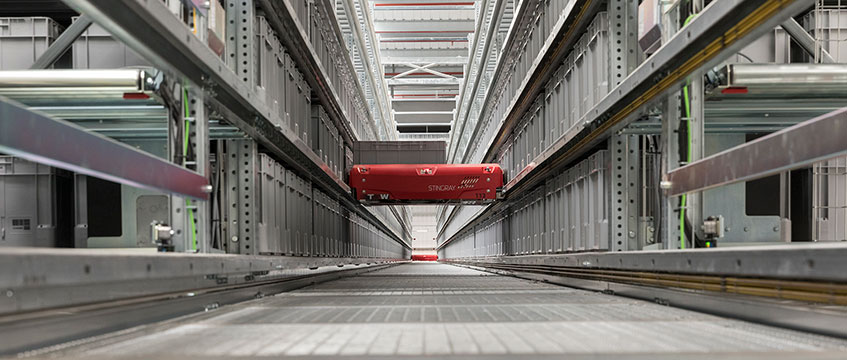The fund manager for Tritax Big Box REIT talks to EG about the industrials outlook, M&A and the opportunities on a “condensed” high street.
Back in 2013, as Tritax Big Box REIT prepared for its London Stock Exchange debut, its directors outlined their vision for the investment firm in the measured style that investors have come to expect from a stock market prospectus.
“A significant opportunity exists in the UK logistics market,” they wrote, “owing to strong tenant demand in high-growth areas of the economy as well as limited stock supply, especially for new, large-scale logistics facilities.”
Almost six years on, with a share price that has risen by more than 40% since the initial public offering, hundreds of millions of pounds in new money raised from investors, a growing portfolio of large logistics properties and an appetite for mergers and acquisitions, the language has grown a little more colourful.
“I’m talking about punching power,” says Colin Godfrey, a partner at Tritax, the manager behind the REIT, as he discusses the state of the business with EG.
International optimism

The specific punching power Godfrey points to comes from February’s £320m acquisition of a majority stake in db Symmetry, a company with a land portfolio ripe for logistics development of more than 2,500 acres. But the firm’s organic growth has been rapid as well, thanks to frequent equity raisings.
The value of Tritax Big Box’s 58-property-strong portfolio, including distribution centres for the likes of Amazon, Sainsbury’s and Royal Mail, rose by almost 13% to reach £3.9bn during the first six months of this year. EPRA NAV grew by about 0.7% once the costs of the db Symmetry acquisition are stripped out.
The UK’s logistics market has boomed, and analysts at JLL expect it to outperform both offices and retail as an investment until at least 2022.
During the first half of this year, according to Savills, investment in distribution warehouses in the UK nudged up by 5% year-on-year to reach £1.5bn, even as overall investment volumes across all commercial property plummeted by 43%.
Savills’ team calculates that yields for prime, single-let logistics now stand at 4.25%, while those for multilet industrial estates stand at 4%, the lowest level ever recorded.
There’s been very little stock available to buy. Many people who own high-quality stock want to sit on it; they don’t want to sell
For Godfrey, the current market performance is validation of the vision Tritax Big Box REIT mapped out back when it revealed plans to list on the London market.
“We said when we came into this market and launched our IPO in 2013 that we expected yields would spin on their head – retail yields would move out dramatically, and industrial adjusted yields would replace them and come down to similar levels to retail yields,” he says. “Some people thought we were mad, but that’s exactly what happened; we called it, bang on, although this was quicker than we expected.”
Now, the UK’s departure from the European Union injects some uncertainty. As the clouds of Brexit gather, even eager buyers in the investment market have pressed pause on their dealmaking, Godfrey adds. But he and his colleagues believe a “very significant wall of money” from domestic and international investors is just on the sidelines.
“The overseas investment market is viewing the UK big box logistics property market with pretty optimistic eyes, to the extent that the weakening of the pound is making investments look a lot more attractive,” Godfrey says.
“They seem to be waiting for more clarity and stability in the UK economy, and the UK’s political situation, before they commit. From our research and the conversations that we continue to have, we expect that this will happen whether we have a hard or soft Brexit.”
Build-your-own
Nonetheless, the market for assets has grown thinner – other than the db Symmetry acquisition, Tritax Big Box made no acquisitions or disposals during its most recent financial half-year. “There’s been very little stock available to buy,” Godfrey says. “Many people who own high-quality stock want to sit on it at the moment; they don’t want to sell.”
That lack of new acquisition targets is one reason that the db Symmetry portfolio and its “punching power” is a major focus now for the team.
“If we’d gone out and bought this land portfolio, fully consented with planning, it would have cost us significantly more [than £320m],” Godfrey says.
“So this is a very efficient way of acquiring control over that land, without the implicit cash drag that comes from having too much money in non-income-producing investments.”
The db landbank will lessen Tritax Big Box’s reliance on direct asset acquisitions to expand its portfolio, taking it into a new chapter of growth in which it develops as well as purchases properties.
“It’s a case of our business moving into a phase where we can organically grow and create that high-quality investment product internally in a controlled manner, rather than rely on the market,” Godfrey adds.
“We can deliver that product at a much more attractive yield and cost. So rather than buying products in the market with a yield of 4.5%, we are looking to create investments with a yield on cost of between 6% and 8%. These are more attractive pricing points that will enhance our income in the longer term.”
Tritax Big Box REIT: key facts and figures
- £3.9bn – Portfolio value
- £2.3bn – Market cap (22 August)
- 58 – Total number of assets
- c. 41m sq ft – Pipeline of logistics assets
- Top 5 clients – Amazon, Morrisons, Howdens, Co-op, Marks & Spencer
De-risking by diversifying
The shift from UK consumers shopping on the high street to buying online underpins Tritax Big Box’s entire investment approach. And despite the fact that the trend is “pretty obvious”, Godfrey adds, it is “still very much in its infancy”.
“The high street will continue to remain relevant, but in a condensed format,” he says. “We think it will be more of a location where, in terms of fashion, you can try on every colour of every size, but you won’t walk out the store with it – it will be on your doorstep when you get home.”
That will play to the strengths of an investor focused on the largest warehouses, Godfrey adds. “These [retail] companies are trying to move away from older, organically grown, disparate networks of inefficient and smaller logistics buildings, and consolidating, say, five or six buildings into one mega-shed.”
Still, this would require quite a bit of planning and inward investment into these buildings – after all, a retailer will not be able to drop its leases overnight.
The firm has become more cautious about which tenants it targets for its properties. “People are rightly keeping a close eye on risk right now, particularly in the context of the retail sector,” Godfrey says.
As such, the REIT has been repositioning its portfolio over the past few years; whereas once it had a core of traditional retail tenants, the push now has been to vary the mix. About a fifth of the REIT’s customer base by income is accounted for by online retailers, with Amazon the main name in that group. Food retailers account for roughly 18%, and homeware and do-it-yourself retail a little under 10%.
“The high street component of our portfolio is very, very low,” Godfrey says. “And then we’ve got a broad mix of other types, such as third-party logistics, manufacturing, electricals, automotive, post and parcels, food production and other services.
“That gives us a really diversified list, which I think de-risks the platform in the face of a long-term slowdown in economic circumstances.”











